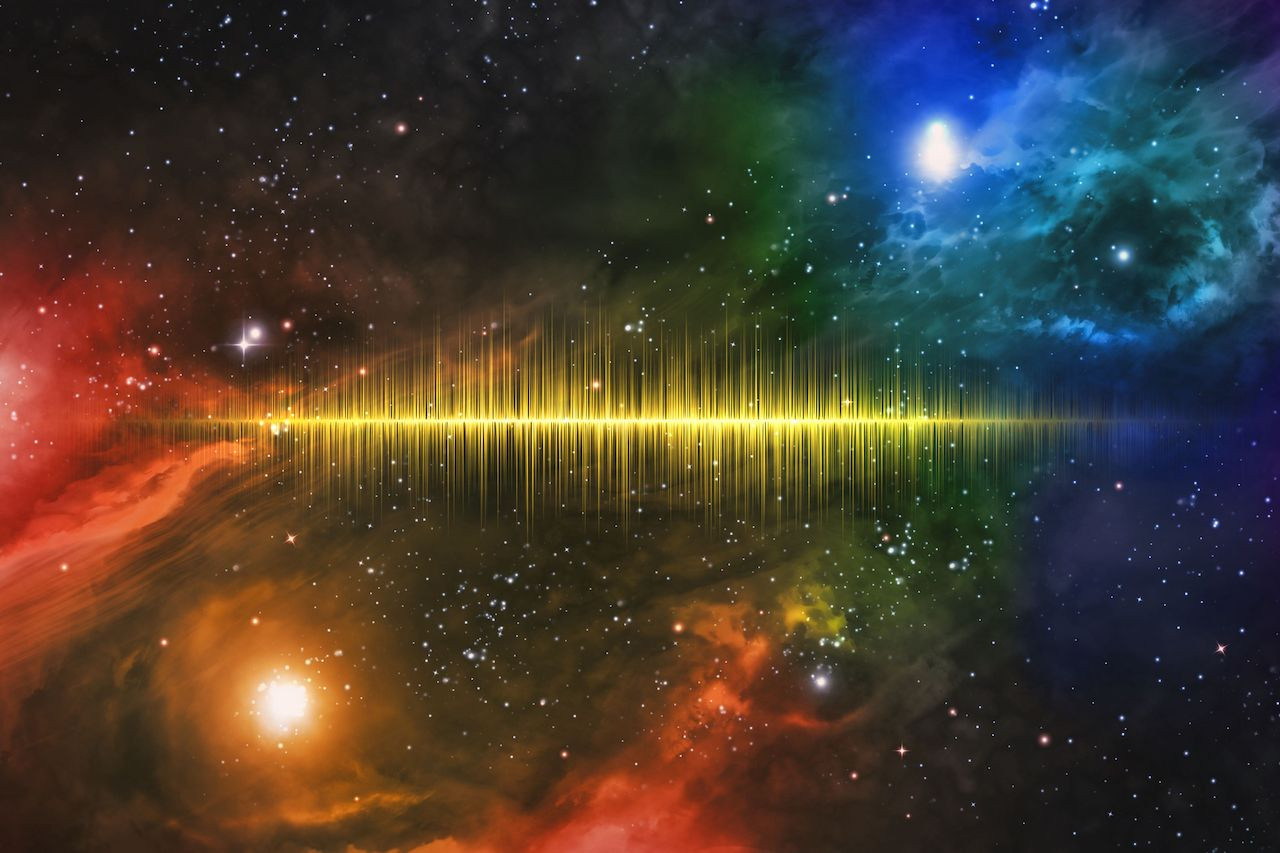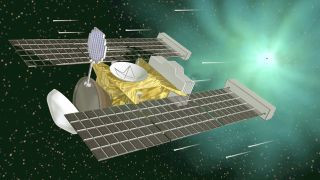What Do Planets Sound Like? Planets actually don’t produce sounds in the way we typically think of them due to the vacuum of space. However, through a process called sonification, astronomical data like radio waves and electromagnetic oscillations can be converted into audible sounds, offering a unique perspective on the universe. Streetsounds.net is your gateway to a vast library of sound effects and urban audio inspiration.
1. The Science Behind Planetary Sounds
The idea of planets having sound is fascinating, but it requires a bit of scientific understanding.
1.1 Sound in Space: Is it Possible?
In the traditional sense, sound, as wavelike vibrations of air molecules, cannot travel through the vacuum of space. According to the BBC, sound requires a medium, such as air or water, to propagate. However, that doesn’t mean we can’t “hear” what’s happening in space.
1.2 Sonification: Turning Data into Sound
Sonification is the process of converting non-acoustic data into audible sound. This involves scaling various types of waves or oscillations, such as radio waves or electromagnetic signals, into frequencies that the human ear can detect. Scientific American notes that this technique has proven beneficial for astronomers, offering new insights into astronomical data.
1.3 How Does NASA Capture Sound in Space?
NASA uses specialized equipment to capture electromagnetic waves. The scientists then use the data to convert those signals to sound. NASA’s Jet Propulsion Laboratory has provided amazing sound clips of our planets.
2. Real Sounds From Mars: NASA’s Perseverance Rover
In 2022, NASA’s Perseverance rover, equipped with microphones, captured the first real sounds from Mars. These recordings offered a fascinating glimpse into the Martian acoustic environment.
2.1 The Martian Soundscape
The sounds recorded by Perseverance included the gust of Martian wind and the snapping sound of the rover’s laser hitting a rock. These audio clips provide a realistic sense of what it might be like to stand on the surface of Mars.
2.2 Differences in Martian Sound
NASA explains that the sounds on Mars are subtly different from those on Earth. The lower density and different composition of the Martian atmosphere make sounds quieter and more muffled.
2.3 What Mars Sounds Reveal
Despite these differences, Perseverance’s recordings reveal that the sounds of Mars are not entirely “alien.” This suggests that some familiar acoustic phenomena exist on other planets.
 Perseverance rover
Perseverance rover
The Perseverance rover on Mars captured the first real sounds from the planet.
3. The Singing Comet: ESA’s Rosetta Mission
One of the most famous examples of sonification comes from the European Space Agency (ESA)’s Rosetta mission to comet 67P/Churyumov–Gerasimenko.
3.1 Low-Frequency Oscillations
During its encounter with the comet in November 2014, Rosetta recorded low-frequency oscillations in the comet’s magnetic field. ESA then scaled up these oscillations by a factor of 10,000 to make them audible.
3.2 “The Singing Comet”
The resulting audio clip, called “The Singing Comet,” became a viral sensation. National Public Radio reported that it was one of the first pure audio clips to achieve widespread popularity, with over 5 million listens on SoundCloud.
3.3 What Comet Sounds Tell Us
“The Singing Comet” demonstrates how sonification can reveal hidden aspects of celestial bodies, turning magnetic field oscillations into an eerie yet captivating auditory experience.
4. Radio Astronomy: Tuning into the Universe
Another method for “hearing” space is radio astronomy, which involves converting radio wave data into audible sounds.
4.1 Fiorella Terenzi: Pioneer of Acoustic Astronomy
Fiorella Terenzi is a pioneer in acoustic astronomy, using it both as a tool for data analysis and as a means of science outreach. According to Popular Mechanics, Terenzi began converting radio waves from distant galaxies into audio form in 1987.
4.2 Radio Waves from Planets
As a professor at Florida International University, Terenzi has applied sonification techniques to radio emissions from planets such as Jupiter and Saturn, as well as the Earth’s magnetosphere. Audio clips of her work are available on her website.
4.3 What Acoustic Astronomy Reveals
Acoustic astronomy allows us to “hear” phenomena that are otherwise invisible, providing a new way to explore the cosmos.
5. Sounds of Earth’s Magnetosphere
The Earth’s magnetosphere, a region surrounding the planet that is controlled by its magnetic field, produces a range of interesting sounds.
5.1 How the Magnetosphere Sounds
These sounds are derived from electromagnetic waves and particle interactions within the magnetosphere. When converted into audio, they can sound like whistles, hums, and crackles.
5.2 Why Study Magnetospheric Sounds?
Studying these sounds helps scientists understand the complex dynamics of the magnetosphere and its interactions with solar wind.
6. Sounds of Jupiter and Saturn
The gas giants Jupiter and Saturn are known for their intense radio emissions, which can be sonified to create otherworldly sounds.
6.1 Juno’s Encounter with Jupiter
In 2016, NASA’s Juno spacecraft crossed the boundary between interplanetary space and Jupiter’s magnetosphere. NASA reported that this event caused an abrupt change in electric field measurements, which were then converted into sound waves. The resulting audio vividly captured the dramatic nature of the change.
6.2 Cassini’s Saturn Recordings
Earlier, NASA’s Cassini probe to Saturn made eerie recordings derived from the planet’s radio emissions. This audio clip displays a wide range of variations in both frequency and time.
6.3 The Link to Saturn’s Aurora
These radio emissions are closely related to Saturn’s aurora, which, like the Earth’s aurora, occurs around the poles of the planet.
7. Landers with Microphones: Capturing Sounds on Other Worlds
In addition to Perseverance, other landers have carried microphones to capture sounds on other worlds.
7.1 Zhurong Rover on Mars
Following Perseverance’s success, China released audio recordings made by its own Mars rover, Zhurong. This provides additional insights into the acoustic environment of the Red Planet.
7.2 Venera 13 on Venus
The Soviet Union’s Venera 13 was the first spacecraft to record sounds on another planet when it landed on Venus in March 1982. These recordings included the sound of Venusian wind and the probe itself hitting the ground.
7.3 Huygens Lander on Titan
The European Space Agency’s Huygens lander carried a microphone on its descent through the atmosphere of Saturn’s moon Titan, capturing the sounds of this alien world.
8. Sounds of a Comet Encounter: Stardust Mission
NASA’s Stardust mission to comet Tempel 1 in 2011 provided another opportunity to “hear” space.
8.1 Dust Impacts
While sound waves can’t travel through space, dust grains and larger debris breaking off the comet could be “heard” when they hit the probe’s protective shield.
8.2 5,000 Impacts
NASA estimates that around 5,000 impacts were detected over an 11-minute period as the spacecraft was pelted by fragments of dust and ice.
8.3 A Unique Sonic Experience
This comet encounter provided a unique sonic experience, as the probe essentially “heard” the sounds of space debris colliding with its surface.
 Stardust probe
Stardust probe
An artist’s impression of the Stardust probe, which recorded sounds of dust impacts from a comet.
9. How to Incorporate Planetary Sounds Into Your Music
Planetary sounds can add a unique and otherworldly dimension to music and sound design.
9.1 Experimenting with Sonification
Musicians and sound designers can experiment with sonification techniques to create original soundscapes from astronomical data.
9.2 Adding a Cosmic Element
Incorporating planetary sounds into your music can add a cosmic element, creating a sense of vastness and mystery.
9.3 Collaboration with Scientists
Collaborating with scientists and astronomers can provide access to new data and insights, enhancing the authenticity and impact of your work.
10. Exploring Streetsounds.net for Unique Audio Inspiration
If you’re looking for unique audio inspiration, Streetsounds.net is the perfect resource.
10.1 Discovering New Sounds
Streetsounds.net offers a vast library of sound effects and urban audio inspiration.
10.2 Connecting with a Community
By visiting Streetsounds.net, you can connect with a community of like-minded artists and sound enthusiasts.
10.3 Finding Your Inspiration
Whether you’re working on a film, game, or music project, Streetsounds.net can help you find the perfect sounds to bring your vision to life.
11. The Future of Space Acoustics
The field of space acoustics is constantly evolving, with new missions and technologies promising even more exciting discoveries.
11.1 Advanced Microphones
Future spacecraft will likely be equipped with more advanced microphones and sensors, capable of capturing a wider range of sounds and signals.
11.2 New Sonification Techniques
Researchers are developing new sonification techniques to translate complex data into more intuitive and informative audio experiences.
11.3 Deeper Understanding of the Universe
These advancements will provide a deeper understanding of the universe, revealing new insights into the nature of planets, comets, and other celestial bodies.
12. E-E-A-T and YMYL Considerations
When discussing topics related to space and astronomy, it’s important to adhere to E-E-A-T (Expertise, Experience, Authoritativeness, and Trustworthiness) and YMYL (Your Money or Your Life) principles.
12.1 Expertise and Experience
Provide accurate information based on scientific consensus and cite credible sources.
12.2 Authoritativeness and Trustworthiness
Establish the credibility of the content by referencing reputable organizations and experts in the field.
12.3 Accuracy and Safety
Ensure that the information presented is accurate and does not promote any harmful or misleading ideas.
13. Examples of Sound Design and Music Incorporating Planetary Sounds
Several artists have incorporated planetary sounds into their work, creating unique and compelling experiences.
13.1 Mickey Hart
Mickey Hart, the former drummer for the Grateful Dead, has produced music using frequencies from space. Smithsonian Magazine has published an article about his work.
13.2 Film Soundtracks
Many film soundtracks incorporate planetary sounds to create a sense of wonder and awe.
13.3 Video Games
Video games often use space-themed soundscapes to enhance the immersive experience.
14. Call to Action: Explore the Sounds of Streetsounds.net
Ready to explore the sounds of the universe? Visit Streetsounds.net to discover a world of audio inspiration.
14.1 Explore Our Library
Browse our vast library of sound effects and urban audio recordings.
14.2 Read Our Articles
Dive into our collection of articles and interviews with sound artists and experts.
14.3 Join Our Community
Connect with a community of like-minded individuals and share your passion for sound.
15. Conclusion: The Sonic Universe Awaits
The universe is full of sounds, both real and imagined. Whether it’s the Martian wind, the singing comet, or the radio emissions of Jupiter, there’s always something new to discover. So, tune in, listen closely, and let your imagination soar.
Exploring the acoustic dimensions of planets and space phenomena offers a captivating blend of science and art. By understanding the principles of sonification and radio astronomy, we can gain a new appreciation for the hidden sounds of the cosmos. Streetsounds.net serves as a launchpad for creative minds seeking to integrate these unique audio elements into their projects, offering a vast library of sound effects and a vibrant community of sound enthusiasts. As we continue to push the boundaries of space exploration, the future of space acoustics promises even more exciting discoveries, inspiring new forms of artistic expression and deepening our understanding of the universe around us. So, whether you’re a musician, sound designer, or simply a curious explorer, the sonic universe awaits your discovery, offering endless opportunities for inspiration and innovation. Don’t just imagine the sounds of space—bring them to life and share them with the world.
16. FAQ: Frequently Asked Questions About Planetary Sounds
16.1 Can we really hear sounds in space?
No, not in the traditional sense. Sound requires a medium to travel through, and space is a vacuum. However, through sonification, we can convert electromagnetic waves and other data into audible sounds.
16.2 What is sonification?
Sonification is the process of converting non-acoustic data into audible sound. This allows us to “hear” phenomena that are otherwise invisible or inaudible.
16.3 How did NASA capture the sounds of Mars?
NASA’s Perseverance rover is equipped with microphones that recorded the sounds of the Martian environment.
16.4 What does the “Singing Comet” sound like?
The “Singing Comet” is an eerie, warbling sound created by scaling up low-frequency oscillations in a comet’s magnetic field.
16.5 What is radio astronomy?
Radio astronomy is the study of celestial objects by detecting and analyzing the radio waves they emit. This data can be converted into audible sounds.
16.6 How can I incorporate planetary sounds into my music?
You can experiment with sonification techniques, use pre-recorded planetary sounds, or collaborate with scientists to create unique soundscapes.
16.7 Is it ethical to sonify data?
Sonification can be a valuable tool for understanding data, but it’s important to ensure that the resulting sounds are not misleading or misinterpreted.
16.8 Where can I find planetary sound effects?
Streetsounds.net offers a variety of sound effects, including some inspired by planetary sounds.
16.9 How can I learn more about space acoustics?
You can explore resources from NASA, ESA, and universities with astronomy programs.
16.10 What are some challenges in capturing sound in space?
The vacuum of space, extreme temperatures, and the need for specialized equipment are some of the challenges.
Address: 726 Broadway, New York, NY 10003, United States.
Phone: +1 (212) 998-8550.
Website: streetsounds.net.

